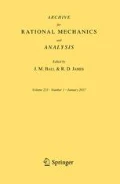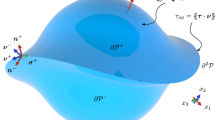Abstract
A mathematical analysis of a new approach to solidification problems is presented. A free boundary arising from a phase transition is assumed to have finite thickness. The physics leads to a system of nonlinear parabolic differential equations. Existence and regularity of solutions are proved. Invariant regions of the solution space lead to physical interpretations of the interface. A rigorous asymptotic analysis leads to the Gibbs-Thompson condition which relates the temperature at the interface to the surface tension and curvature.
Similar content being viewed by others
References
L. I. Rubinstein, “The Stefan Problem”, Am. Math. Soc. Transl. 27, American Mathematical Society, Providence, (1971).
J. R. Ockendon & W. R. Hodgkins, eds., Moving Boundary Problems in Heat Flow and Diffusion, Oxford Univ. Press, Oxford (1975).
D. G. Wilson, A. D. Solomon, & P. T. Boggs, eds., Moving Boundary Problems, Academic Press, New York (1978).
A. Fasano & M. Primicerio, eds., Proce. Montecatini Symposium on Free and Moving Boundary Problems, Springer, Berlin Heidelberg New York (1981).
C. M. Elliott & J. R. Ockendon, Weak and Variational Methods for Moving Boundary Problems, Pitman Publishing, London (1982).
A. Friedman, Variational Principles and Free-Boundary Problems, John Wiley and Sons, New York (1982).
O. A. Oleinik, “A Method of Solution of the General Stefan Problem”, Sov. Math. Dokl. 1 (1960), 1350–1354.
I.I. Kolodner, “Free Boundary Problem for the Heat Equation with Applications to Problems of Change of Phase”, Comm. Pure Appl. Math. 10 (1957), 220–231.
A. Friedman, “The Stefan Problem in Several Space Variables”, Trans. Amer. Math. Soc. 133 (1968), 51–87.
A. Friedman, “Analyticity of the Free Boundary for the Stefan Problem”, Arch. Rational Mech. Anal. 61 (1976), 97–125.
D. Kinderlehrer & L. Nirenberg, “The Smoothness of the Free Boundary in the One Phase Stefan Problem”, Conm. Pure Appl. Math. 31 (1978), 257–282.
L. I. Rubinstein, “The Stefan Problem: Comments on its Present State”, J. Inst. Math. Appl. 24 (1979), 259–278.
L. A. Caffarelli, “Continuity of the Temperature in the Stefan Problem”, Indiana Univ. Math. J. 28 (1979), 53–70.
L. A. Caffarelli, “Some Aspects of the One Phase Stefan Problem”, Indiana Univ. Math. J, 27 (1980), 73–77.
L. A. Caffarelli & L. C. Evans, “Continuity of the Temperature for the Two Phase Stefan Problem”, Arch. Rational Mech. Anal, (to appear).
J. Chad Am & P. Ortoleva, “The Stabilizing Effect of Surface Tension on the Development of Free Boundaries”, Proc. Montecatini Symposium on Free and Moving Boundary Problems, Springer, Berlin Heidelberg New York (1981).
B. Chalmers, Principles of Solidification, R. E. Krieger Publishing, Huntington, New York (1977).
P. Hartman, Crystal Growth: An Introduction, North-Holland Publishing, Amsterdam (1973).
J. W. Gibbs, Collected Works, Yale University Press, New Haven, (1948).
D. W. Hoffman & J. W. Cahn, “A Vector Thermodynamics for Anisotropic Surfaces I. Fundamentals and Application to Plane Surface Junctions”, Surface Science 31 (1972), 368–388.
J. W. Cahn & D. W. Hoffman, “A Vector Thermodynamics for Anisotropic Surfaces II. Curved and Faceted Surfaces”, Acta Metallurgica 22 (1974), 1205–1214.
W. W. Mullins, “The Thermodynamics of Crystal Phases with Curved Interfaces: Special Case of Interface Isotropy and Hydrostatic Pressure”, Proc. Int. Conf. on Solid-Solid Phase Transformations, H. I. Erinson, et al., eds., TMS-AIME, Warrendale, Pennsylvania (1983).
W. W. Mullins, “Thermodynamic Equilibrium of a Crystal Sphere in a Fluid”, J. Chem. Phys. 81 (1984), 1436–1442.
L. D. Landau & E. M. Lifshitz, Statistical Physics, Addison-Wesley Publishing, Reading, Massachusetts (1958).
C. J. Thompson, Mathematical Statistical Mechanics, MacMillan Co., New York (1972).
H. E. Stanley, Introduction to Phase Transitions and Critical Phenomena, Oxford University Press, Oxford (1971).
J. W. Cahn & J. E. Hilliard, “Free Energy of a Nonuniform System I. Interfacial Free Energy”, J. Chem. Phys. 28 (1957), 258–267.
J. W. Cahn & J. E. Hilliard, “Free Energy of a Nonuniform System III. Nucleation in a Two Componente Incompressible Fluid”, J. Chem. Phys. 31 (1959), 688–699.
J. S. Langer, “Theory of the Condensation Point”, Annals of Physics 41 (1967), 108–157.
P. C. Hohenberg & B. I. Halperin, “Theory of Dynamic Critical Phenomena”, Reviews of Modern Physics 49 (1977), 435–480.
G. Fix & J. T. Lin, Paper in preparation.
W. W. Mullins & R. F. Sekerka, “Morphological Stability of a Particle Growing by Diffusion or Heat Flow”, J. Appl. Physics 34 (1963), 323–329.
W. W. Mullins & R. F. Sekerka, “Stability of a Planar Interface During Solidification of a Dilute Binary Alloy”, J. Appl. Physics 35 (1964), 445–451.
J. R. Ockendon, “Linear and Non-linear Stability of a Class of Moving Boundary Problems”, Proc. Sem. Pavia 1979 Technoprint, Free Boundary Problems 1 (1980), 443–478.
J. Smith, “Shape Instabilities and Pattern Formation in Solidification: A New Method for Numerical Solution of the Moving Boundary Problem”, J. Comp. Physics 39 (1981), 112–127.
J. Smoller, Shock Waves and Reaction —Diffusion Equations, Springer-Verlag, Berlin Heidelberg New York (1983).
H. Weinberger, “Invariant Sets for Weakly Coupled Parabolic and Elliptic Systems”, Rend. Mat. 8 (1975), 295–310.
K. Chueh, C. Conley, & J. Smoller, “Positively Invariant Regions for Systems of Nonlinear Diffusion Equations”, Indiana Univ. Math. J. 26 (1977), 373–392.
J. Bebernes, K. Chueh, & W. Fulks, “Some Applications of Invariance for Parabolic Systems”, Indiana Univ. Math. J. 28 (1979), 269–277.
N. Alikakos, “An Application of the Invariance Principle to Reaction-Diffusion Equations”, J. Diff. Eqns. 33 (1979), 202–225.
H. Amann, “Invariant Sets and Existence Theorems for Semilinear Parabolic and Elliptic Systems”, J. Math. Anal. Appl. 65 (1978), 432–467.
A. Friedman, Partial Differential Equations of Parabolic Type, Prentice-Hall, Inc., Englewood Cliffs, New Jersey (1964).
D. Gilbarg & N. S. Trudinger, Elliptic Partial Differential Equations of Second Order, Springer-Verlag, Berlin Heidelberg New York (1977).
O. A. Ladyzenskaya, V. A. Solonnikov. & N. N. Uralceva, “Linear and Quasilinear Equations of Parabolic Type”, Trans. of Math. Monographs 23, American Mathematical Society, Providence (1968).
S. D. Eidelman, Parabolic Systems, North Holland Publishing, Amsterdam (1969).
M. S. Berger & L. E. Fraenkel, “On the Asymptotic Solution of a Nonlinear Dirichlet Problem”, J. Math. Mech. 19 (1970), 553–585.
P. Fife & W. M. Greenlee, “Interior Transition Layers for Elliptic Boundary Value Problems with a Small Parameter”, Russian Math. Surveys 29 (1974), 103–131.
A. Van Harten, “Nonlinear Singular Perturbation Problems: Proofs of Correctness of a Formal Approximation Based on a Contraction Principle in a Banach Space”, J. Math. Anal. Appl. 65 (1978), 126–168.
F. A. Howes, “Boundary-interior Layer Interactions in Nonlinear Singular Perturbation Theory”, Mem. Amer. Math. Soc. 203 (1978).
M. S. Berger, Nonlinearity and Functional Analysis, Academic Press, New York (1977).
K. Yosida, Functional Analysis, Springer-Verlag, Berlin Heidelberg New York (1965).
N. Hicks, Notes on Differential Geometry, Van Nostrand, Princeton, New Jersey (1965).
Author information
Authors and Affiliations
Additional information
Communicated by C. M. Dafermos
Rights and permissions
About this article
Cite this article
Caginalp, G. An analysis of a phase field model of a free boundary. Arch. Rational Mech. Anal. 92, 205–245 (1986). https://doi.org/10.1007/BF00254827
Received:
Issue Date:
DOI: https://doi.org/10.1007/BF00254827



